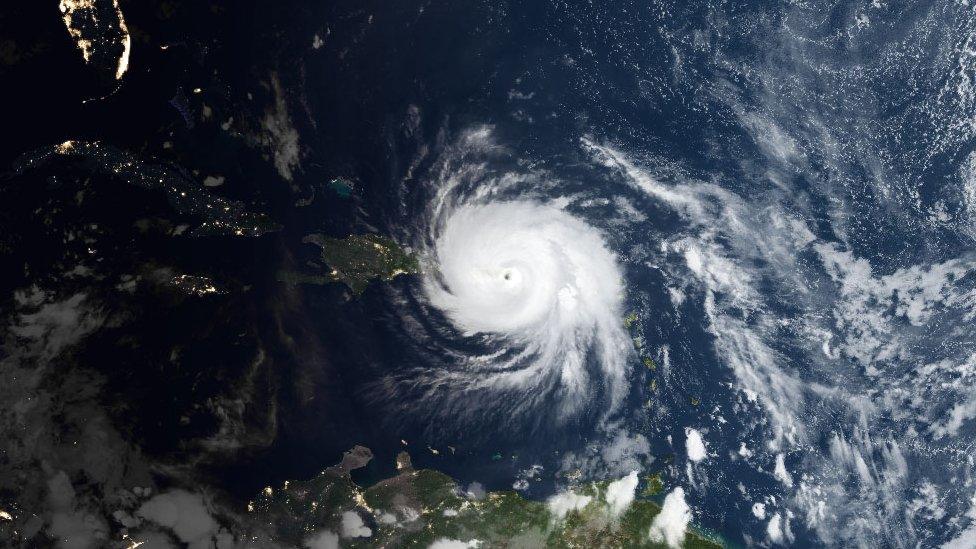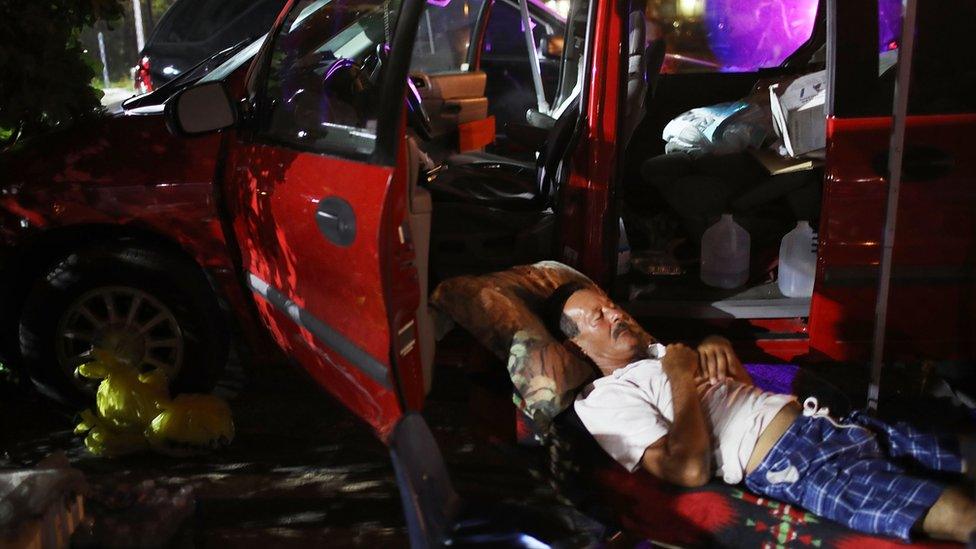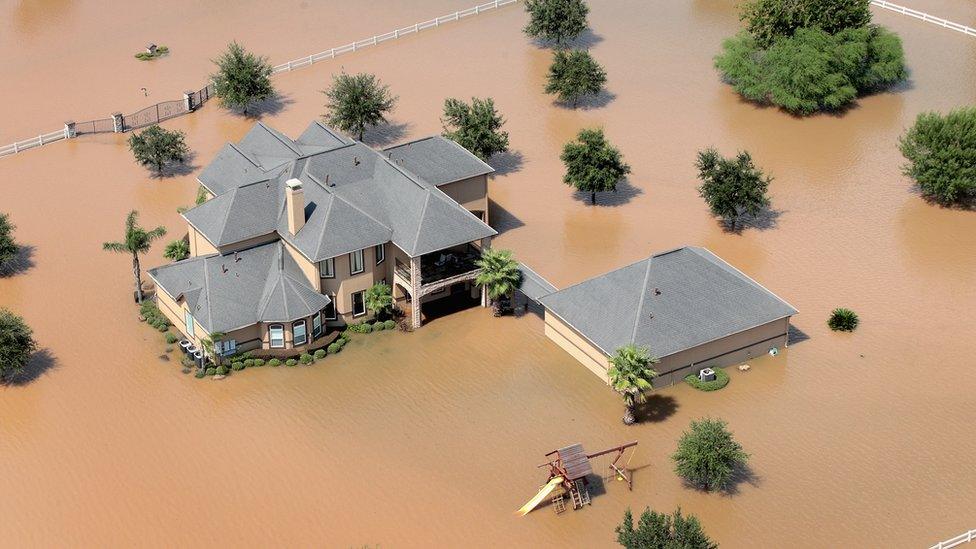Hurricanes: A perfect storm of chance and climate change?
- Published
- comments

The swirling edges of Hurricane Maria seen from space as it slammed into Puerto Rico
The succession of intense and deadly tropical cyclones that have barrelled across the Atlantic in recent weeks have left many people wondering if a threshold of some sort has been crossed. Is this chain of hurricanes evidence of some significant new frontier in our changing climate?
The answer is mostly no, but with worrying undertones of yes.
The first thing to note about this season is that it shows the power of science and weather forecasting.
Every year, the US National Oceanic and Atmospheric Administration (Noaa) puts out a hurricane forecast for the season that runs from 1 June to 30 November for the north Atlantic, Caribbean and the Gulf of Mexico.
In August, Noaa updated its predictions, stating that there would be 14-19 named storms and of these, 5-9 would become hurricanes.
To date, we've had seven cyclones, with four that have gained category three status or stronger. So this season is unusual but not unprecedented. The bigger picture shows that between 1981 and 2010 the average was six hurricanes per season.
What has happened this year is that a number of natural variable factors have come together and helped boost the number and power of these cyclones. In the background, climate change has loaded the dice.

Hurricane Maria has left devastation in its path across the Caribbean
This season has been particularly warm in the region of the Atlantic where hurricanes form with temperatures 0.5 to 1.0C above average, according to Noaa.
A wetter and stronger monsoon in West Africa and a natural cycle called the Atlantic Multi-Decadal Oscillation (AMO) have also helped boost the energy available for the massive, swirling heat engines that hurricanes become.
Another factor that has helped so many storms form is the lack of wind shear.
Some scientists believe that because this is a neutral El Niño year, there has been less wind shear which tends to break these storms apart.
"There haven't been the upper-level wind flow or lower pockets of moisture that can often erode these storms; all these factors have come together this year," said Prof Richard Allan from the department of meteorology at the University of Reading, UK.
"It relates primarily to the weather, but also the slower fluctuations in the ocean that you get from year to year have produced an unusually strong hurricane season."
That view is echoed by Kerry Emanuel, an eminent atmospheric scientist at the Massachusetts Institute of Technology (MIT), US.
"The number of hurricanes in the Atlantic varies a great deal from year to year for reasons that have to do with natural climate fluctuations like El Niño and also just plain random variability," he told BBC News.
"A lot of it is just sheer chance."
Those who have been sceptical of the impact of carbon emissions from human sources on the climate have crowed about the fact that it has been 12 years since a hurricane rated category three or above has made landfall in the US.
But those working in the field believe that measuring the connection between hurricanes and climate change based on the number that make land is hugely mistaken.

Some of those who fled their homes ahead of Hurricane Irma had to sleep in their cars
"Hurricane Andrew in 1992, which was the most damaging of any US hurricane, occurred in a very quiet year," said Kerry Emanuel.
"That's just because the noise is so large and we are looking for these small signals - A busy year is no guarantee that you are going to see a major hurricane [make] landfall."
Most researchers who study extreme events like hurricanes agree that climate change is most likely making the impacts of these events much worse.
Rising temperatures lead to warmer air holding more moisture, which causes more intense downpours in a hurricane. The oceans have risen thanks to thermal expansion and glacier melt and this works to increase the dangers posed by storm surges.
"In terms of the factors that control the genesis and the intensification of these hurricanes, a number of these point to the fact that they will undoubtedly be slightly more severe due to the extra heat content in the ocean due to the long-term warming of the climate," said Richard Allan.

Experts say the downpours caused by Hurricane Harvey could become more common
Kerry Emanuel strongly agrees.
"The warming of the climate has increased the underlying probabilities of very heavy rain events like happened in Harvey and very high category hurricanes like Irma.
"It is just not sensible to say either storm was caused by climate change, but the underlying probabilities are going up."
Both experts believe that these factors are making the current round of hurricanes more threatening - but they are also making weather-related events, such as the recent floods in South East Asia, much more dangerous.
"There are other damaging events going on, particularly flooding, in other parts of the world which link into the same physics as is impacting the hurricanes," said Richard Allan.
"So even though it might be a normal monsoon season in the Indian sub-continent, the amount of rain that will fall will likely be more as the air can hold more moisture."
Right now the Intergovernmental Panel on Climate Change (IPCC) says there is low confidence in attributing changes in hurricane activity to rising temperatures - but in its fifth and latest assessment report in 2013, it argued that this perspective was likely to change.
"The frequency of the most intense storms will more likely than not increase substantially in some basins," the report says.
"More extreme precipitation near the centres of tropical cyclones making landfall are likely in North and Central America, East Africa, West, East, South and Southeast Asia, as well as in Australia and many Pacific islands."
Climate scientists say that to see the full impact of emissions of greenhouse gases on hurricanes, you really have to look at the long-term record.
"The evidence is that there is not really going to be an increase in the number of tropical cyclones but there is certainly some evidence that the strongest hurricanes will become more intense," said Richard Allan.
"In terms of the rainfall and the storm surges that's very strong evidence that the amount of rain that will fall out of these intense hurricanes will be greater and storm surges will be higher and more deadly."
Follow Matt on Twitter, external and on Facebook, external